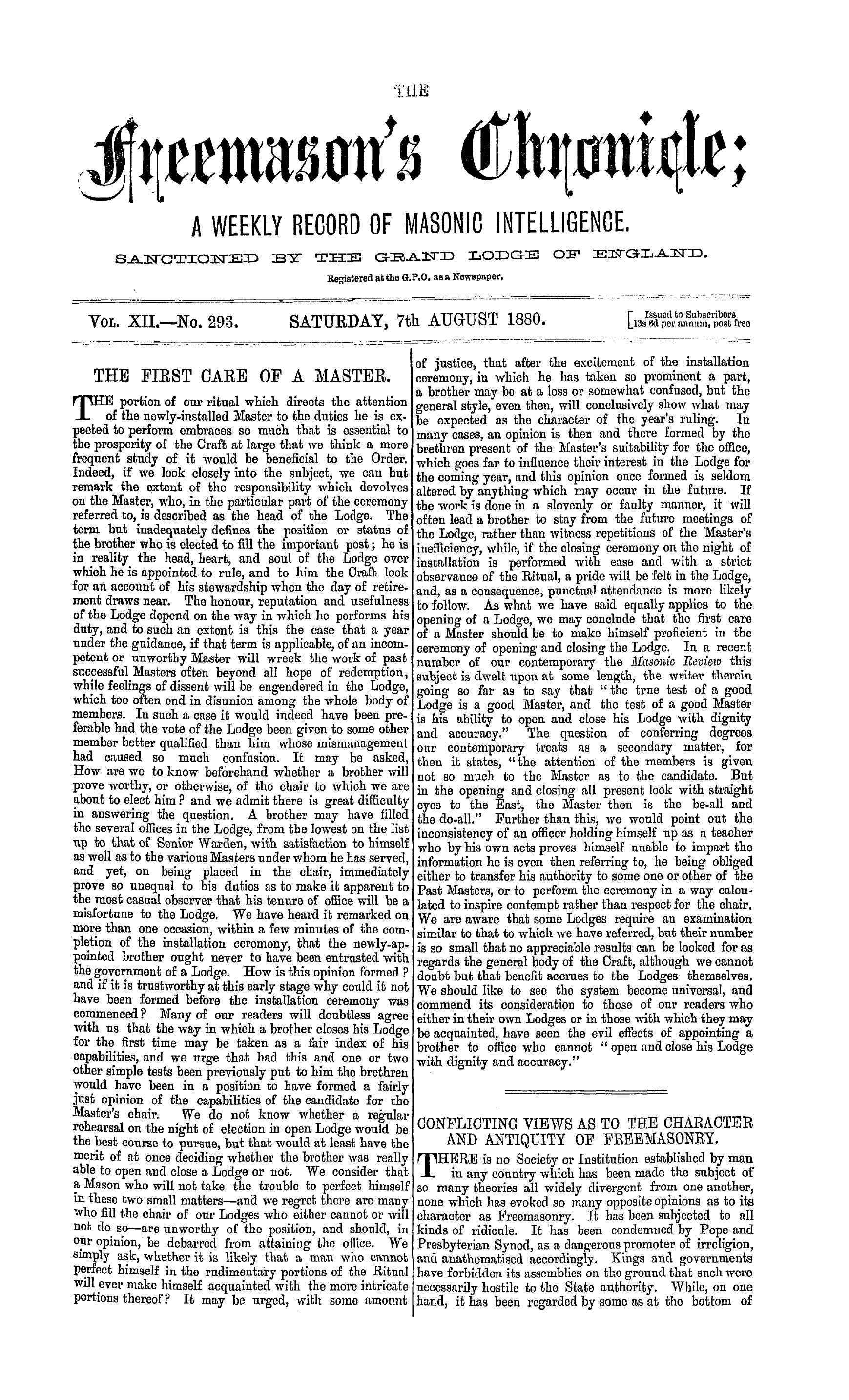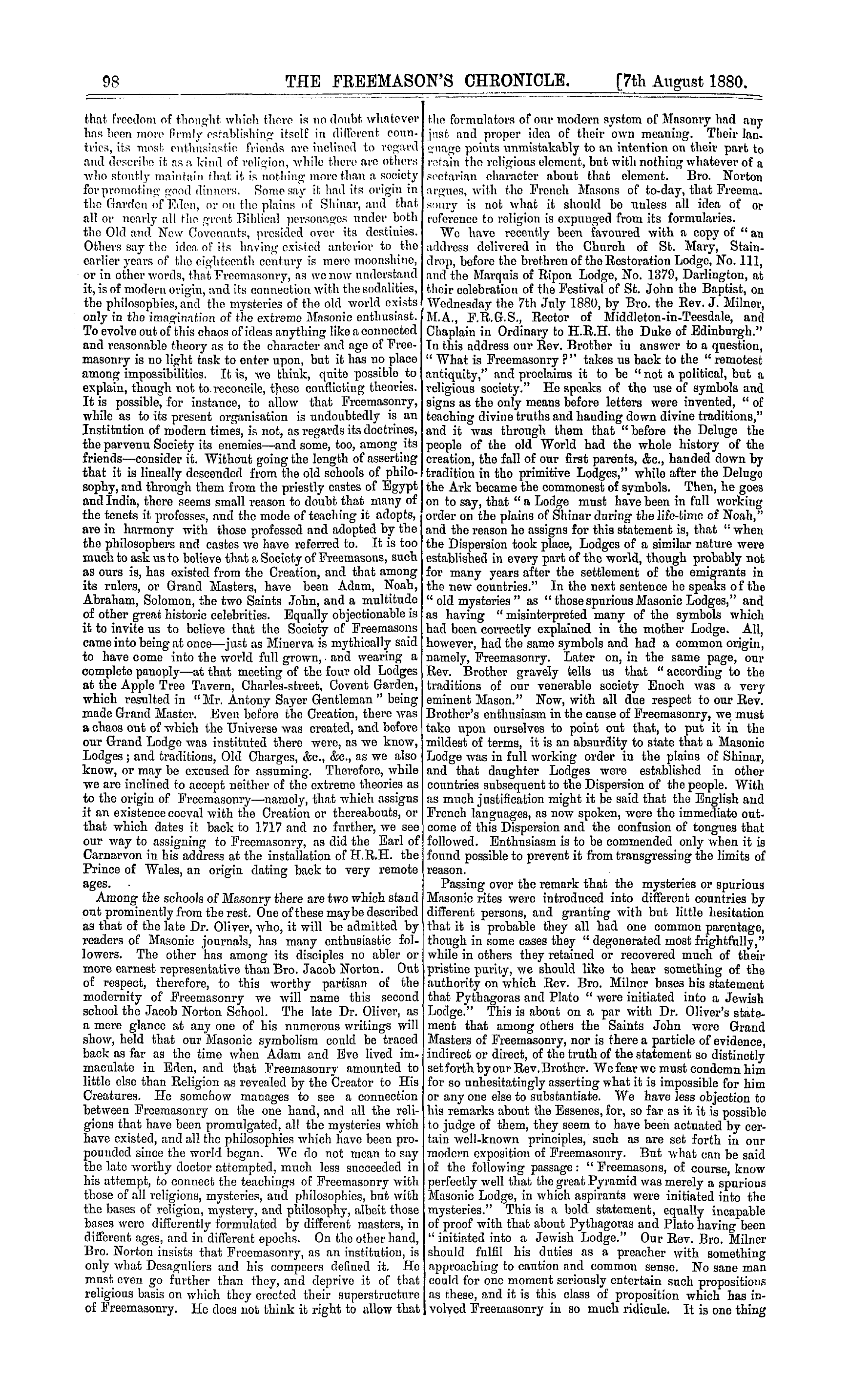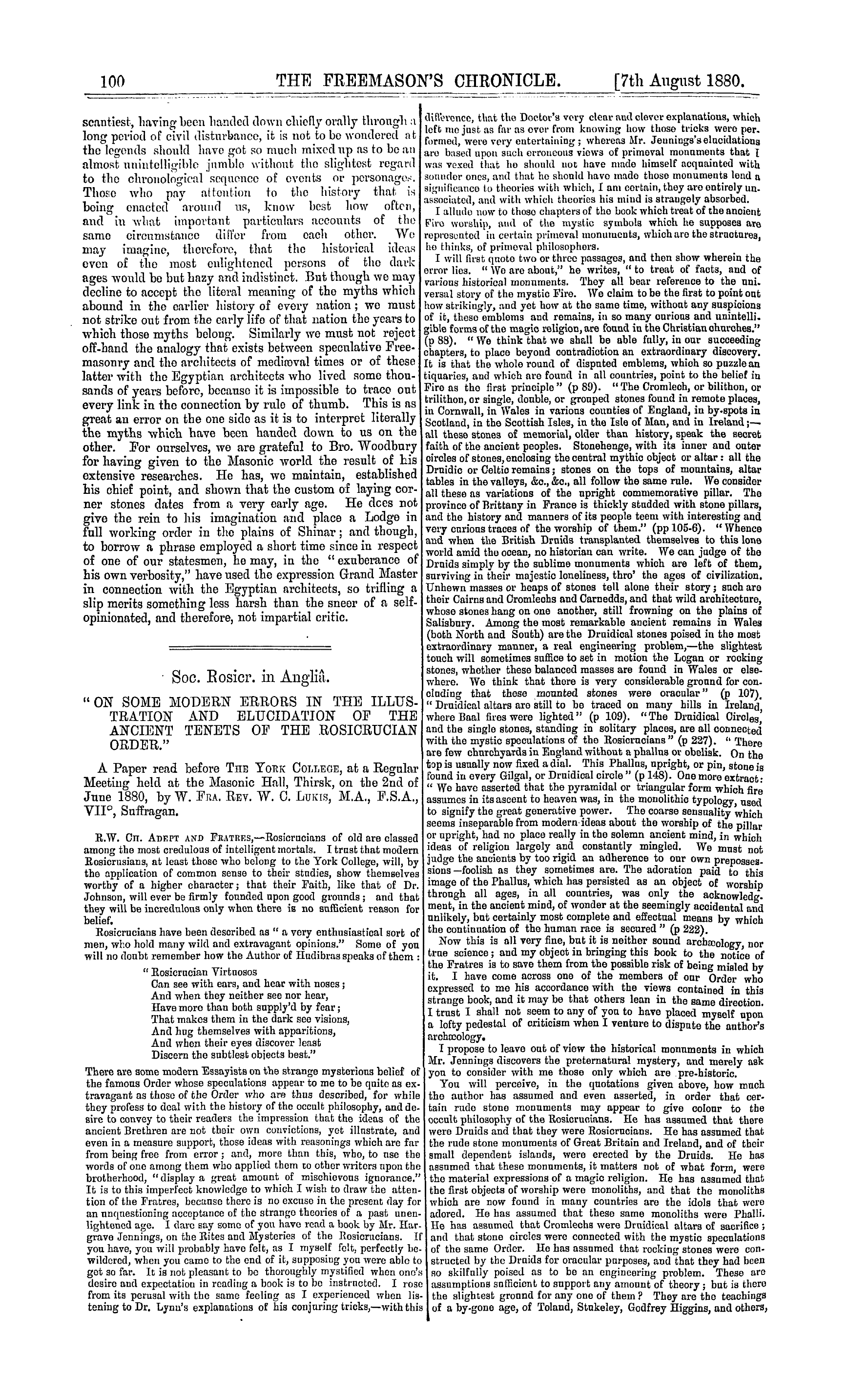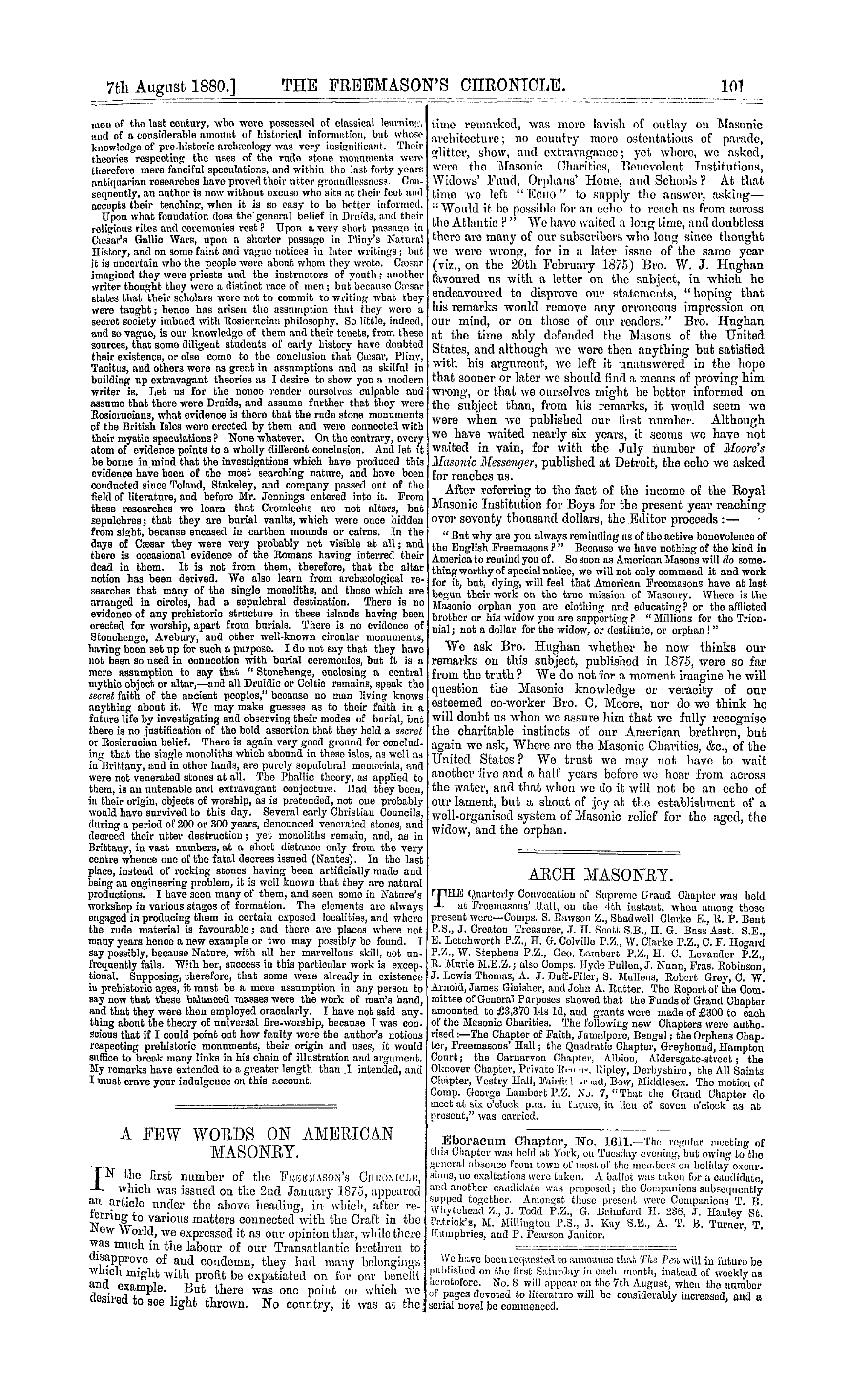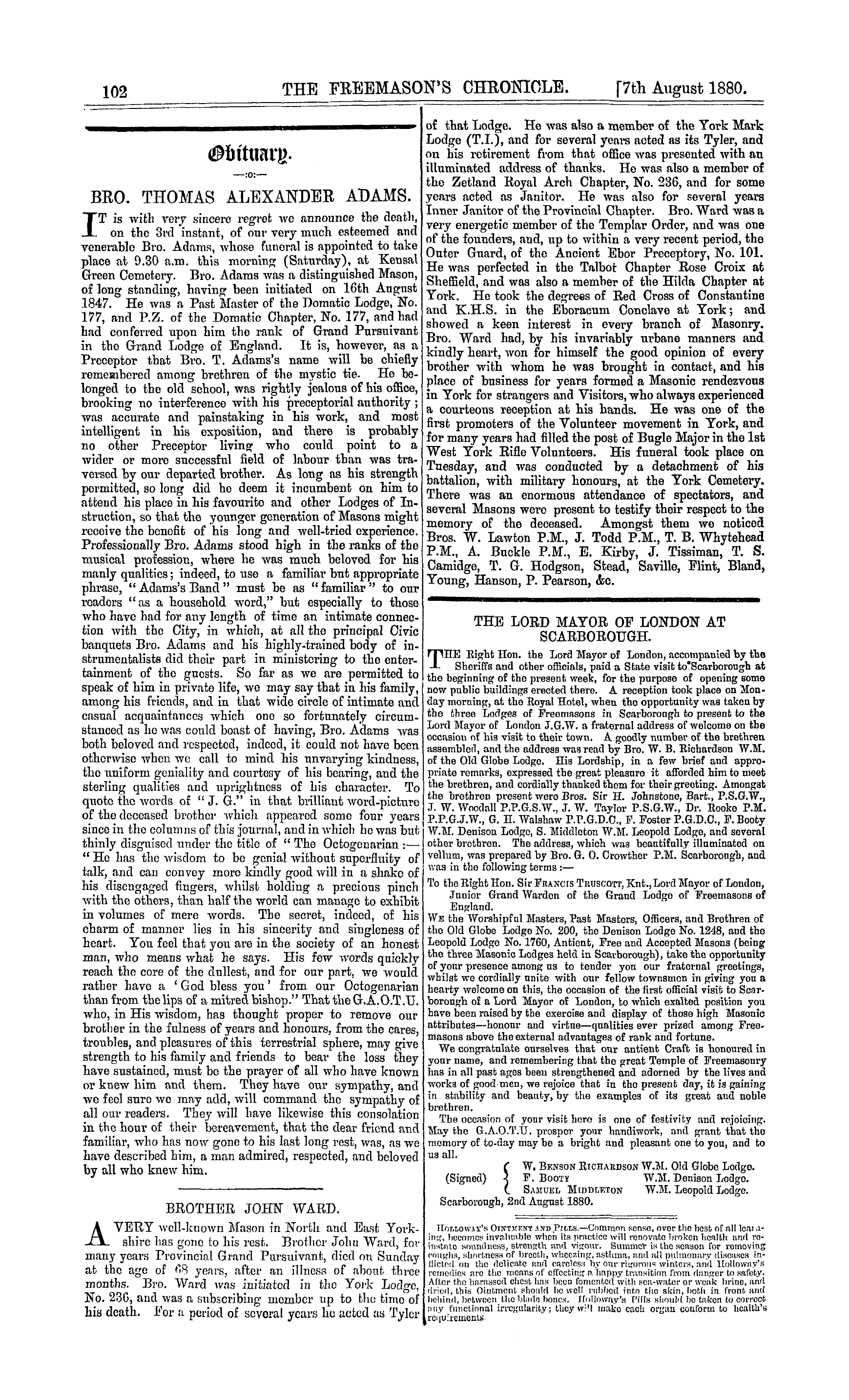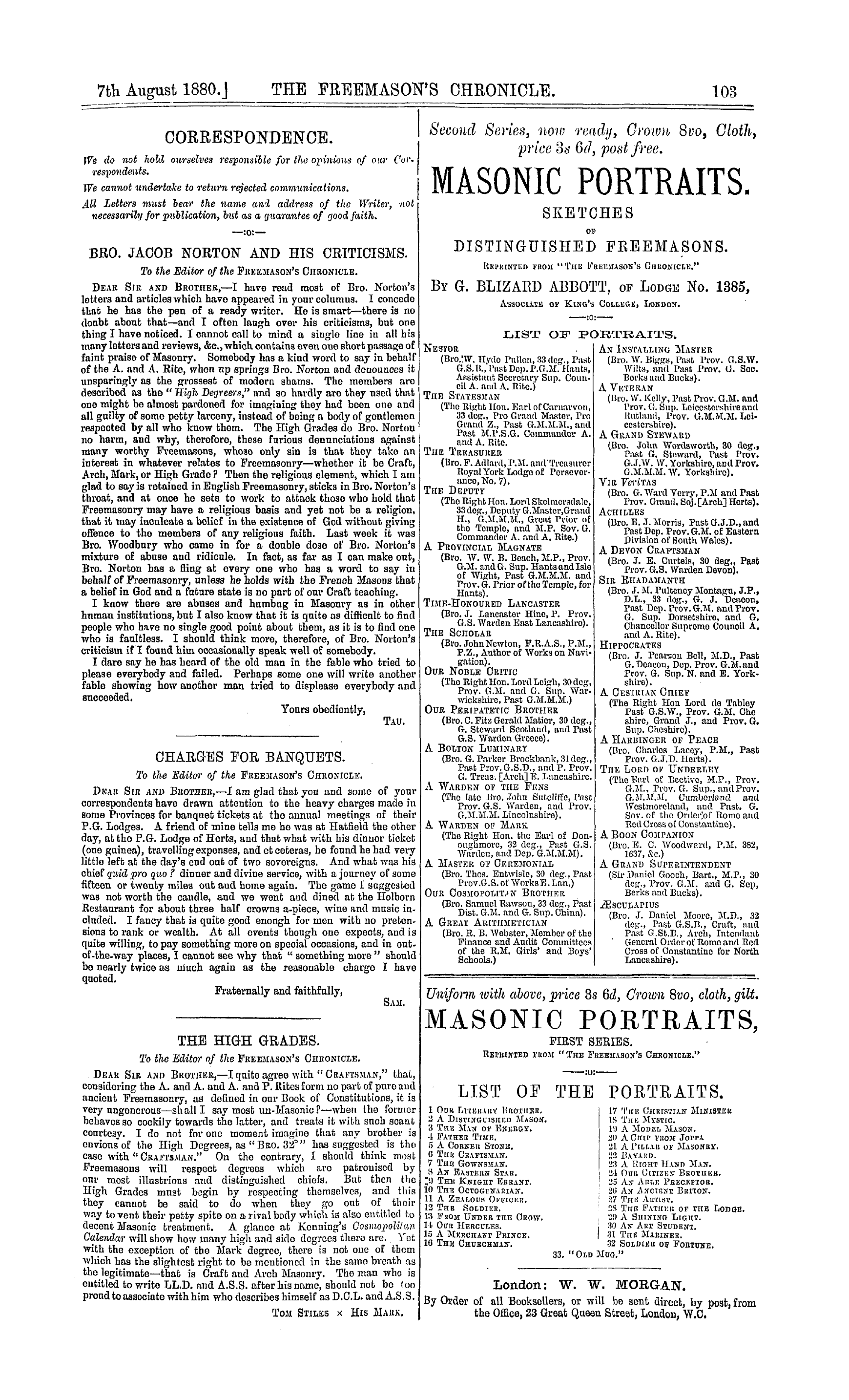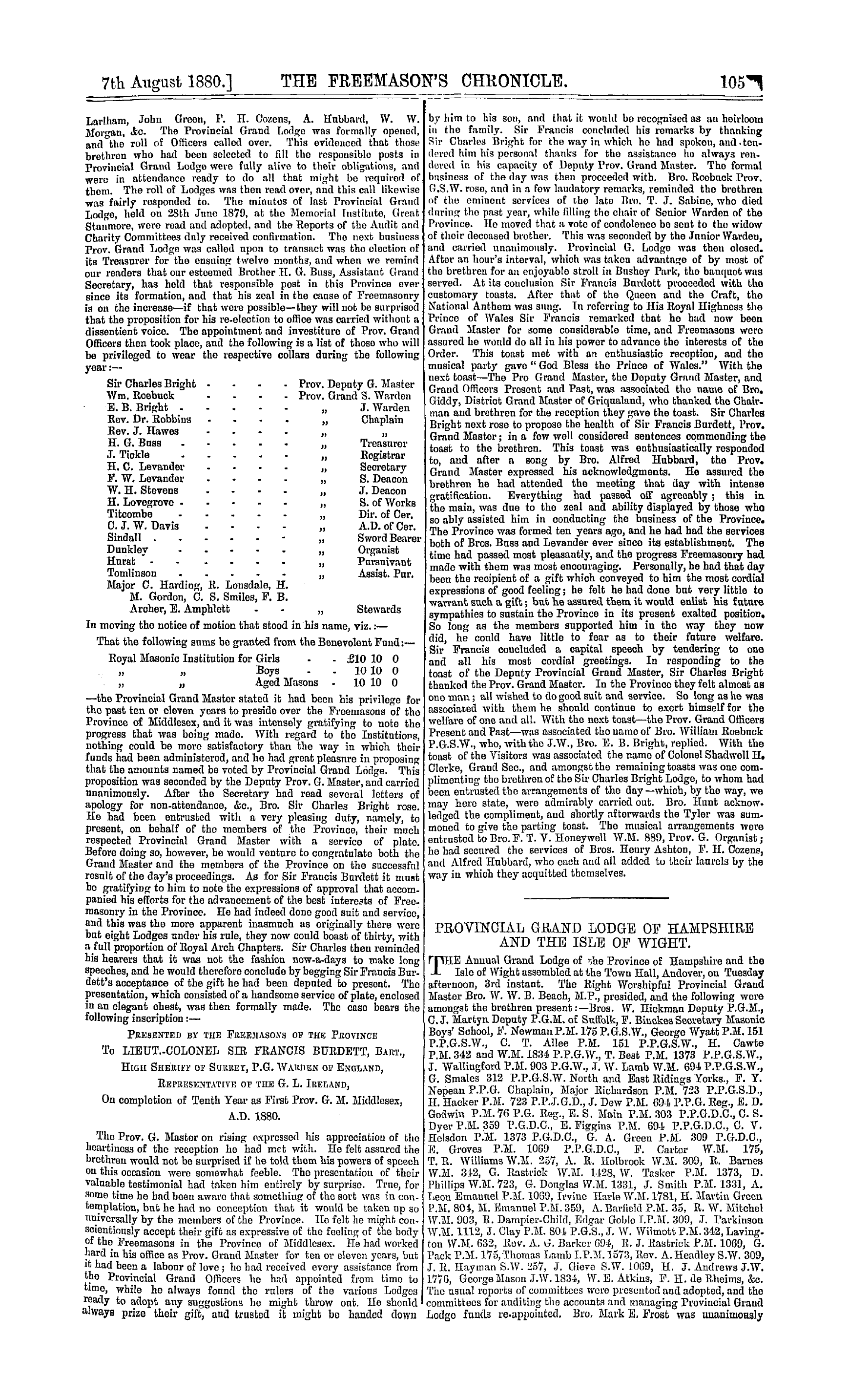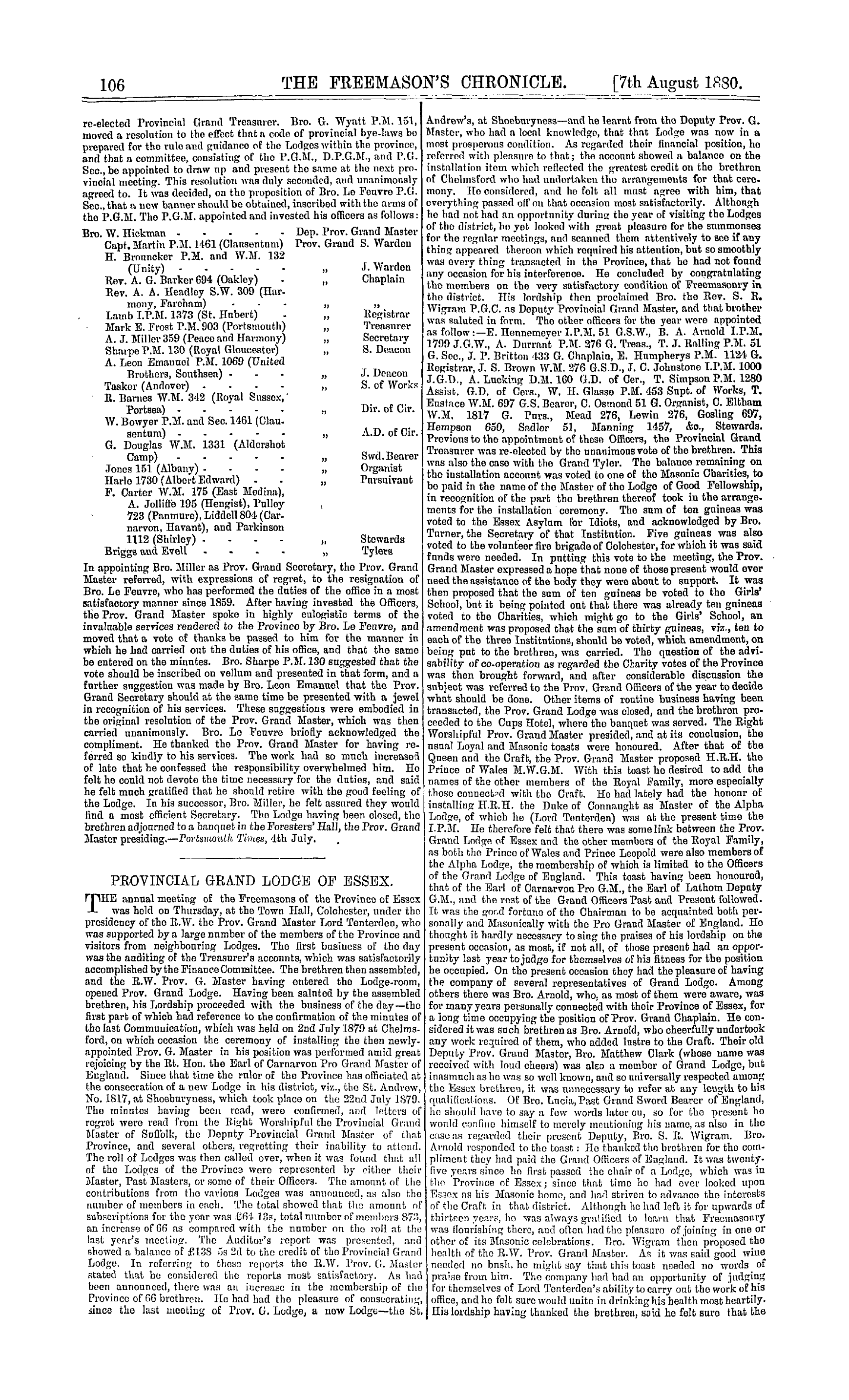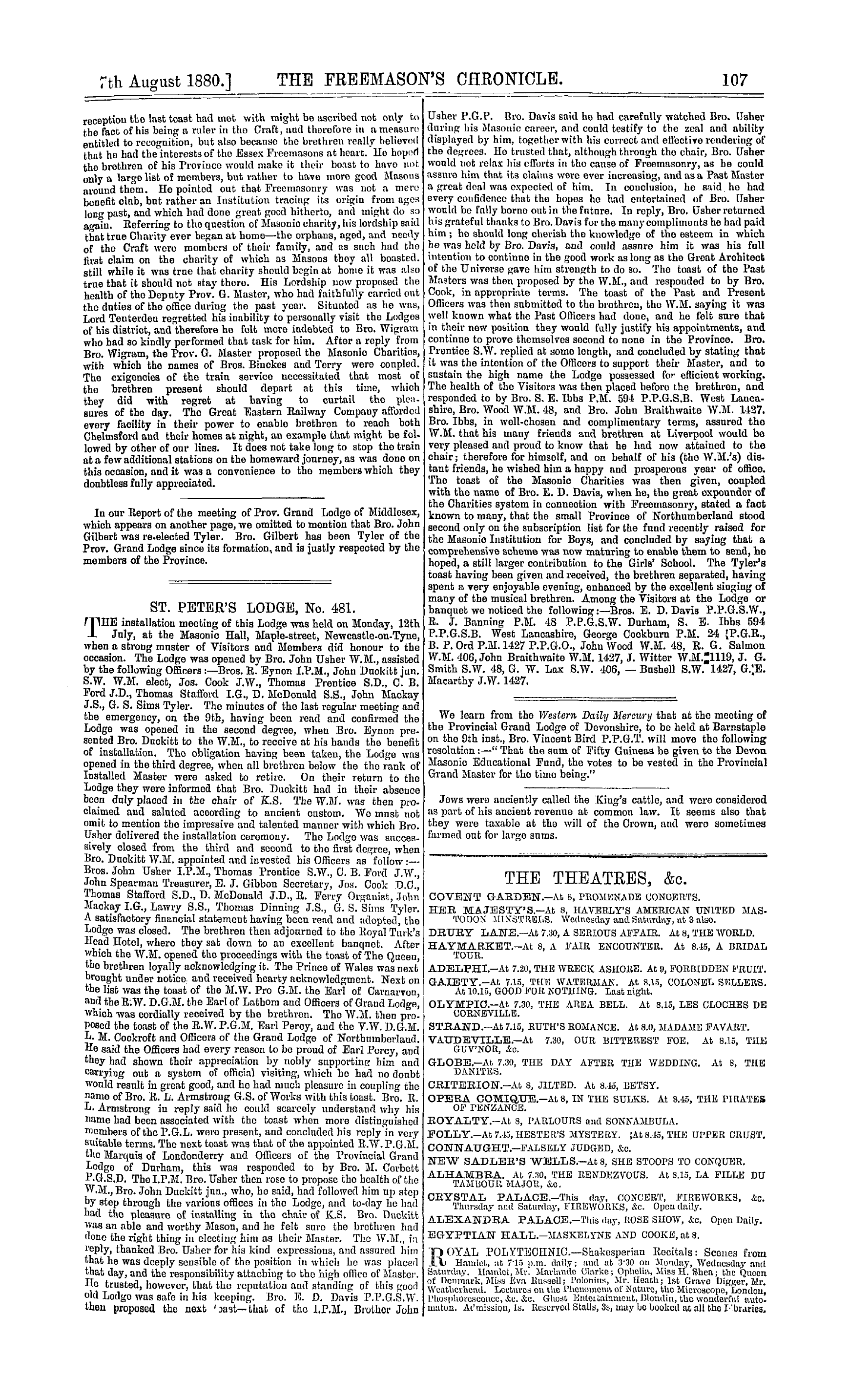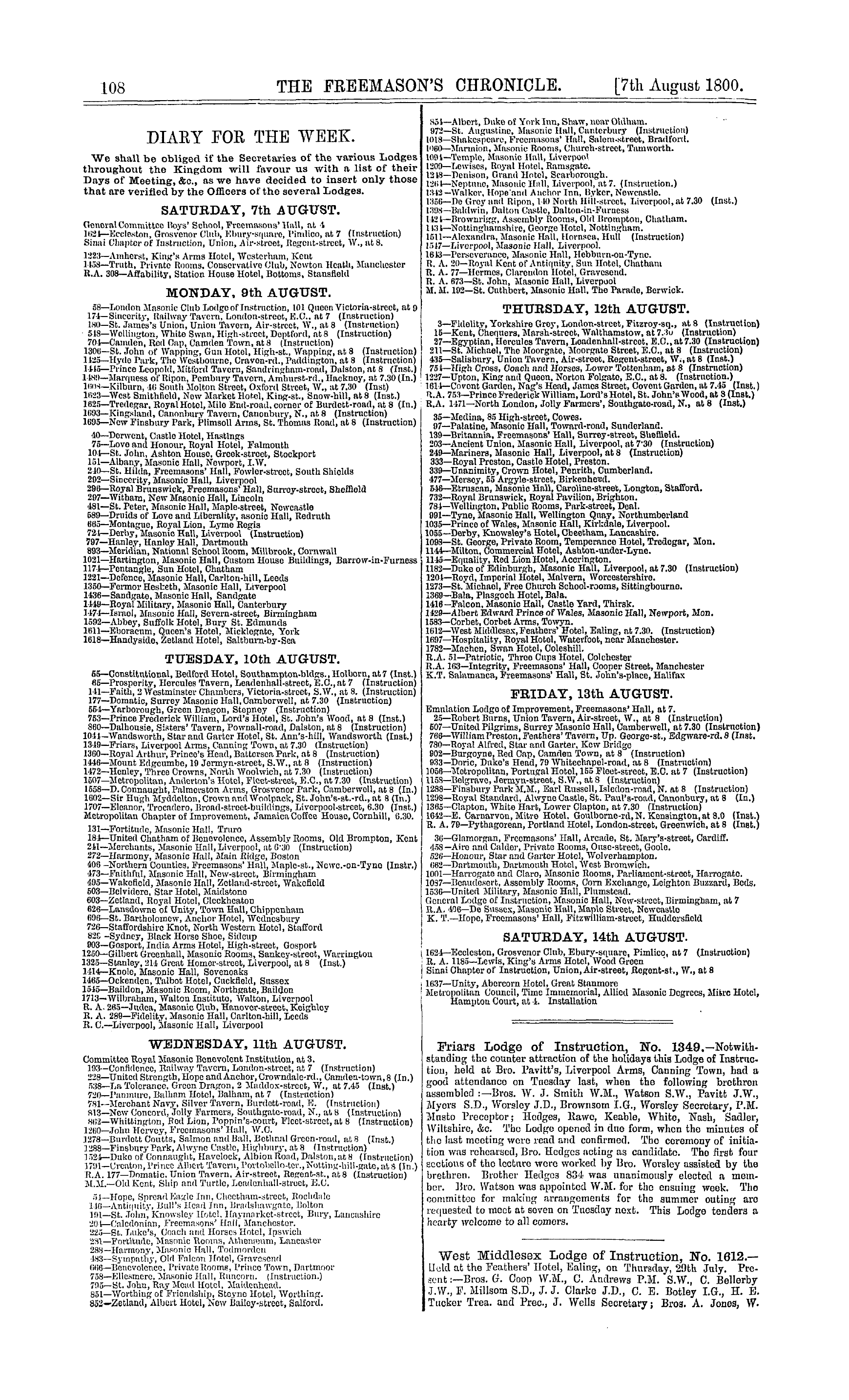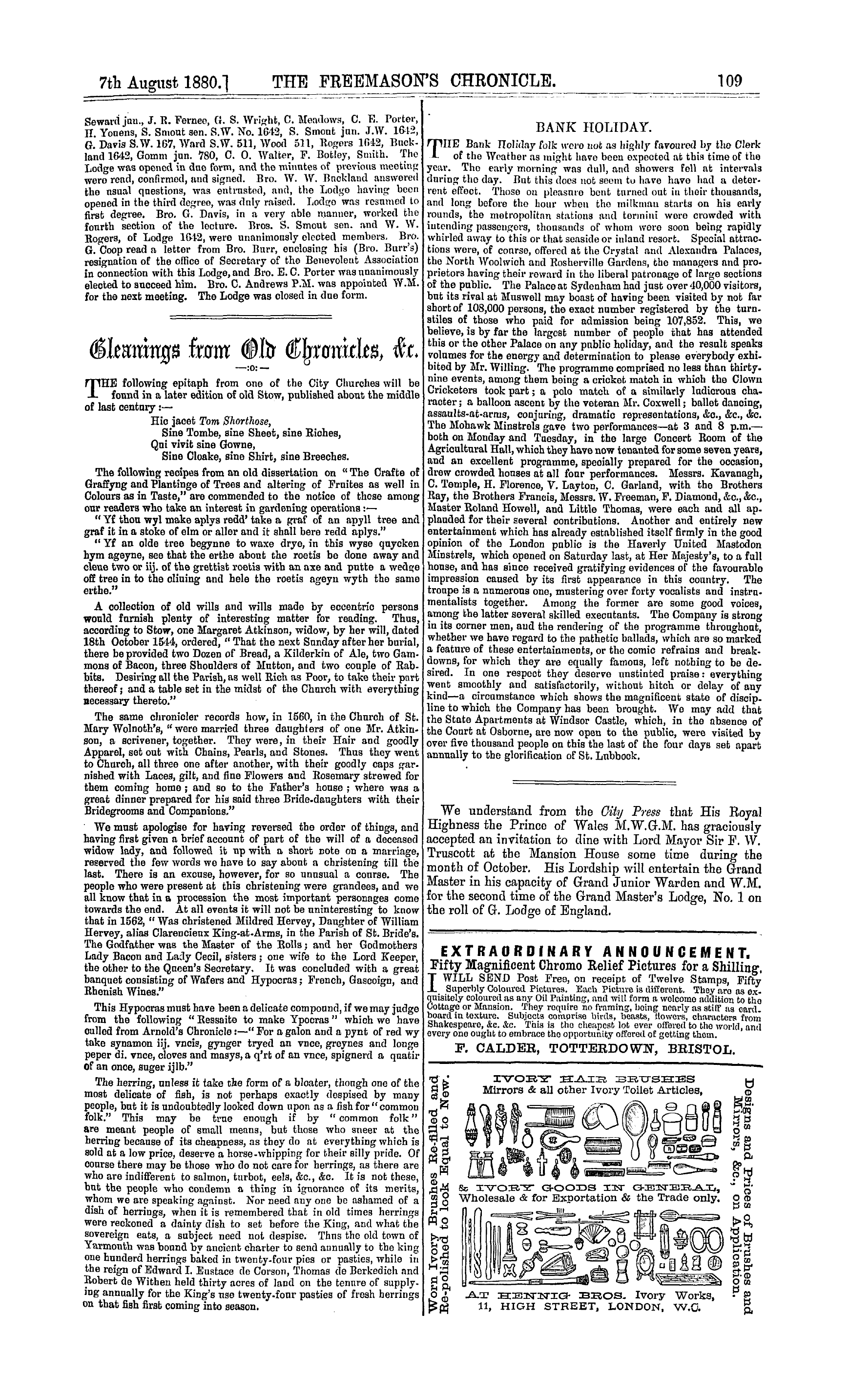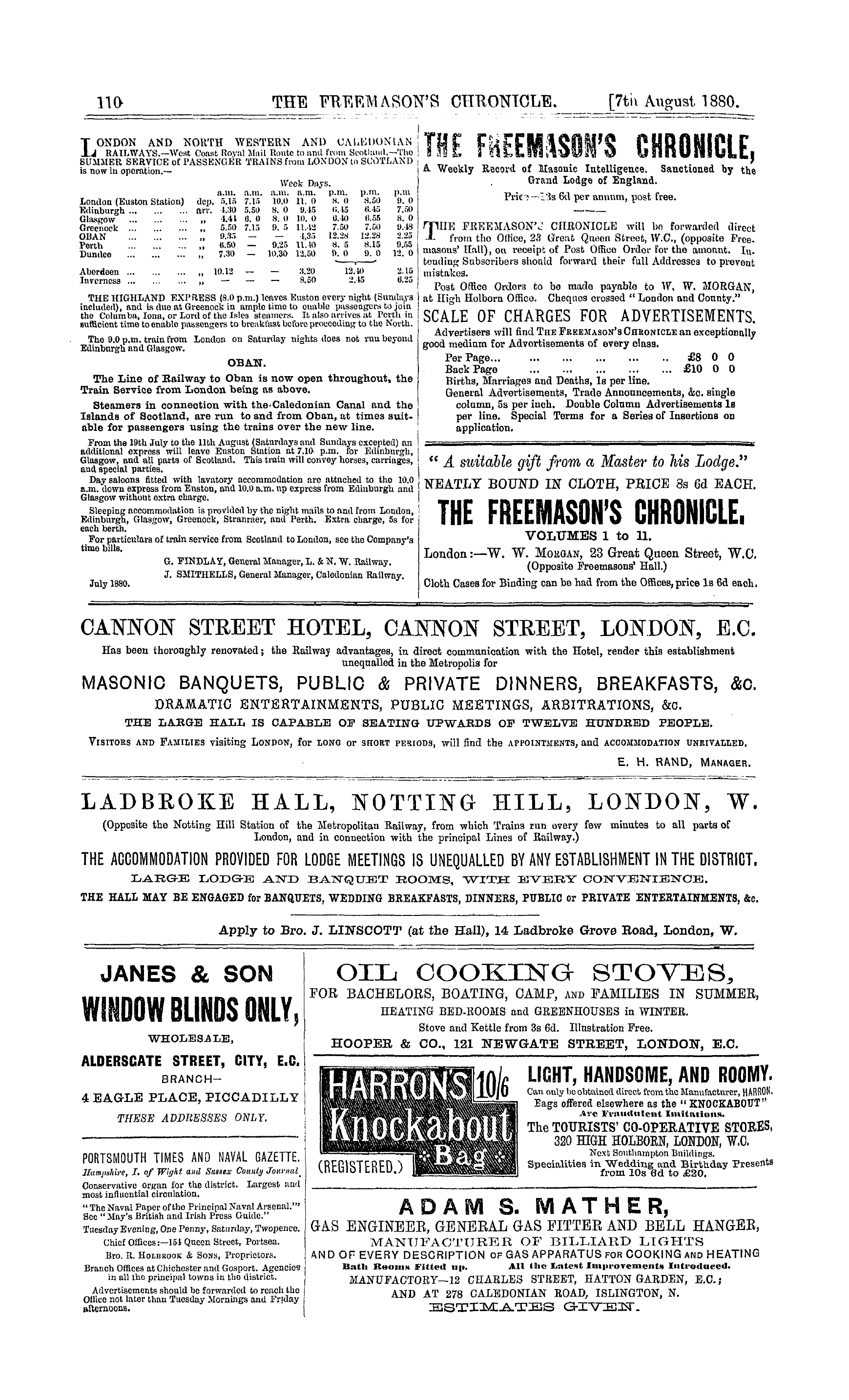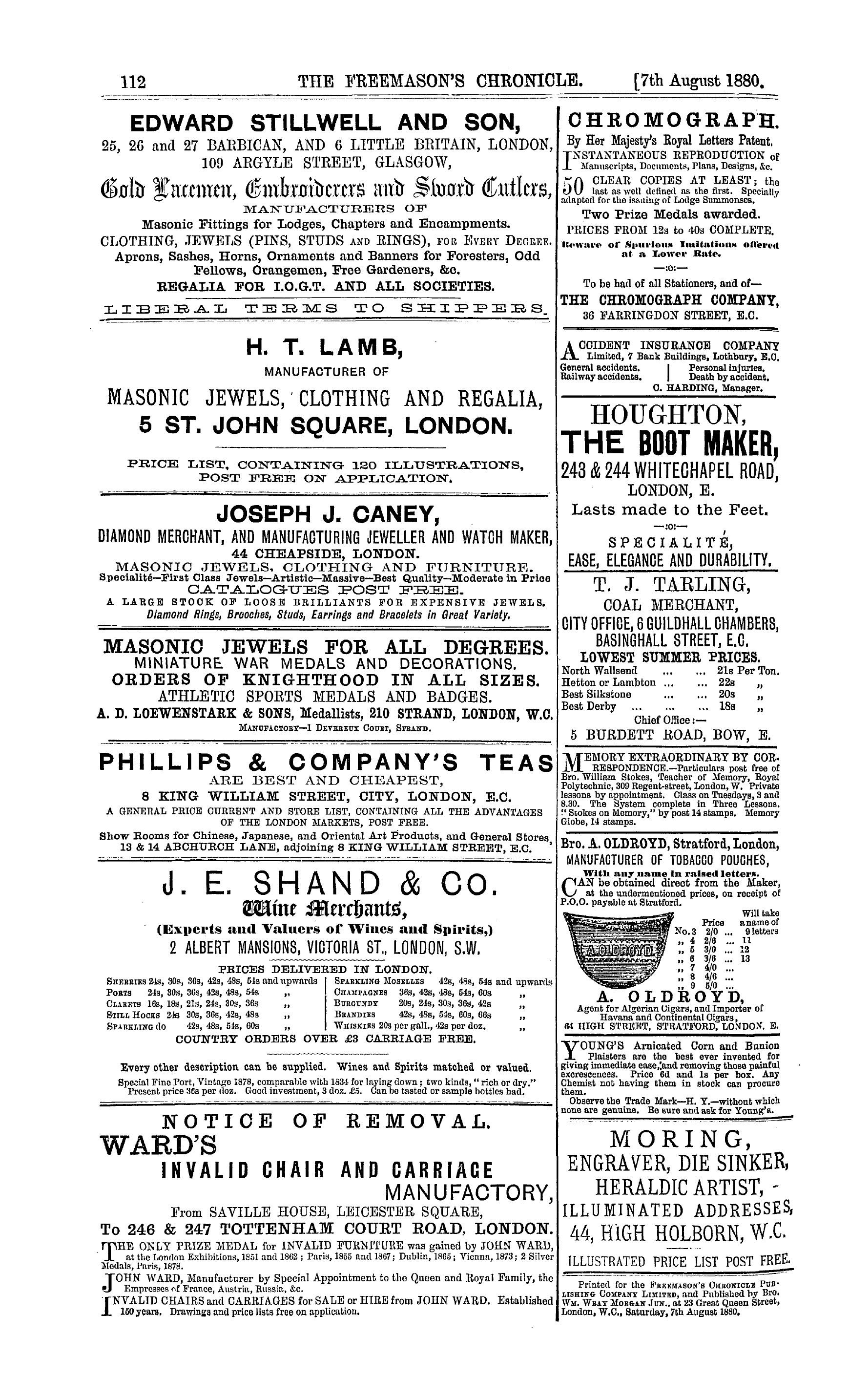Note: This text has been automatically extracted via Optical Character Recognition (OCR) software.
Conflicting Views As To The Character And Antiquity Of Freemasonry.
to claim for our society a " Time Immemorial " existence , as it is called , but in doing this we must avoid the capital error of fabricating a connection botwcen Freemasonry as it is known to us brethren of our own day , and all the different faiths inculcated by all the different religions of
the world and all the different schools of philosophy that ever existed . Thero is , perhaps , no serious objection to any one describing the Garden of Eden or tho plains of Shinar as being the place where the first or mother Lodge of Freemasons was held—except as regards the former , that
women are not eligible for admission into our Lodges—but while we may amuse ourselves with such an idea , we must not trespass too seriously on the patience and credulity of others and publicly invite them to accept such belief or description .
Let us now turn our attention to tho views of the opposite school of thought respecting Freemasonry , as fairly represented by Bro . Jacob Norton . We shall not need to devote so much space to him , as the papers which appear in these columns from time to time contain sufficient evidence
of the character of his Masonic creed . He is for reducing Freemasonry to the very narrowest proportions . He would eliminate all reference to religion from our ritual , and , no doubt , from our Constitutions likewise . He holds that Freemasonry is nothing more than a system of morality ,
and he uses tho word " morality" as , a long time ago , a correspondent of ours pointed out , in the narrowest sense . That is , he holds that Freemasonry has been devised for the purpose of inculcating practically , as well as by precept , the virtues of temperance , forbearance , patience , fortitude ,
charity , chastity , & c . & c , and condemning their respective antagonistic vices . If some brother , as in the case recently of Bro . Woodbury , in his interesting paper on the " Antiquity of the Laying of Corner Stones , " sees , or imagines that he sees , some analogy between the rites of
Freemasonry as they are now practised , and the mystic teaching of the priests or philosophers of former times , up rises Bro . Norton spontaneously and at once , and in a long and elaborate article sets to work battering the new thesis into atoms—no matter how interesting or probable the
analogy may be . The reading of Bro . Woodbury's article afforded us so much pleasure that we determined on reproducing it in our columns , nor did we find anything that merits to be ridiculed even by Bro . Norton . In our judgment
Bro . Woodbury established his point as to the antiquity of laying Corner Stones . It did not need a very elaborate article to prove the esteem in which architecture and those who were learned in the art were held in Egypt , the wealth of monumental and architectural remains which are still to
be met with in that country bear testimony to this . It is easy to imagine that kings would take an interest in structures about to be erected in commemoration of their virtues , or success in war , and that those who designed them and superintended their erection might not only be
held in high esteem , but even be rewarded for their ability , with positions of rank about the person of their sovereign , if not in the sovereign ' s family . We are indebted for much of what we know about Egypt , Assyria , and other great powers of the East in ancient times , to the remains of their
temples , palaces , pyramids , obelisks , & c , and the inscriptions on them , so the learned tell us , have in a wonderful way borne out the biblical account of the fortunes of those states . Bro . Woodbury has adduced valuable testimony , from various sources , all tending to
show that the Egyptian kings took a practical interest in buildings that were about to be erected to their honour or for the public good , that interest being shown by the part they played in laying the foundation stones . This function they discharged with much pomp
and ceremony , just as did the bishops or other high ecclesiastics in mediaeval times in laying the corner stones of churches , and just as we Freemasons of to-day on such occasions as that of laying the foundation stones of Truro Cathedral . The resemblance may not be complete in
all its details . We may use corn , wine , and oil , the ecclesiastics may have used salt and water , and the Egyptians neither or nothing at all , but a small matter of that kind does not suffice to destroy the very striking analogy which Bro . Woodbury has sought , not in our
opinion unsuccessfully , to establish between the architectural mysteries of ancient Egypt and the mysteries of our speculative Freemasonry of to-day . Another important feature to which Bro . Woodbury has drawn attention is , the association of these architects and Master Masons with the priestly caste , the members of which reserved the
Conflicting Views As To The Character And Antiquity Of Freemasonry.
knowledge of all tho most valued mysteries , allowing nothing but the most ordinary matters to become known ontside their own sacred circle . So with Freemasonry —• and any one who wishes may acquire from published hooks a fairly comprehensive idea of Freemasonry—tho
important mysteries are properly expounded only in Lodges . There is also this further point to bo urged ; as architecture and priestcraft were closely associated in ancient Egypt , so religion still finds a place in the expositions of Freemasonry . These are matters of agreement which
deserve a better fate than to be sneered at by a hostile critic , who believes in nothing but his own omniscience , and is never happy but when he is actively engaged in tho attempted demolition of somebody else ' s pet theory . Is it obtuseness on the part of Bro . Norton that he cannot see as other men see—not as members of the Oliverian
school to whom we have already objected—but as men of learning and research , possessing keen judgment and plenty of common sense , who , like Lord Carnarvon , hold that Freemasonry dates back from a remote antiquity , or Bro . Woodbury who does not think he is indulging his
imagination when he discovers some analogy between the architects of early Egypt and tho Freemasonry of modern times ? These are not unsafe guides for thoughtful men to follow . They are men who have played a practical part in the affairs of life . They are capable of forming an
opinion of the fantastic ideas of the mere visionary , and are not likely to involve us in a nme of vain imaginings . There is generally more rather than less reason in any theory they may propound . In the particular instance before us Bro . Woodbury has broached a theory which
will certainly bear the closest investigation , and Bro . Norton treats him to a page of ridicule , good-natured we admit , but none the less ridicule . Let us take a single point of Bro . Norton ' s for an example . He loves antitheses , and so in his attempt to show there was nothing in
common between mediteval and Egyptian Freemasonry he remarks , "the main object of the supposed Egyptian fraternity was for studying the science of architecture , & c . ; but the whole aim and object of the mediaeval associations was merely bread and btitter . " No
doubt our worthy brother thinks this is a smart piece of criticism , but if wo look into it a little , we shall come to tho conclusion that it is very childish . Bro . Woodbury has shown that in Egypt even kings did not consider it beneath them to study architecture and its associate
arts . He has also drawn a distinction between the grand old architects of the dark ages , who travelled about Europe , planning and designing , and erecting under the a ? gis of the Church those religious fabrics , so many of which exist as monuments of their skill and ability , from the mere
stone masons and bricklayers who worked under their guidance . The former were the repositories of such art knowledge as the priests were of such book lore as had survived the convulsions which followed the destruction of civilised society after the break-up of the Roman empire ,
by the northern barbarians . No wonder , then , that architecture and religion went hand-in-hand together . The mere layers and hewers of wood and stone were villeins , serfs , or slaves , who in time , however , became sufficiently powerful to organize themselves into a Fraternity or Guild for the
purpose of securing to themselves a sufficient price for their labour , and subsequently to set at naught Acts of Parliament , which at different times were framed to resist their
pretensions . In time the art element lost its commanding influence , and the mere operative element almost alone remained to represent the glorious Fraternities of Architects and master builders of mediaeval times . These
Fraternities derived such knowledge as they possessed of the arts and sciences , through the Roman Colleges and the schools of philosophy in Greece and Italy , from the earliest times , and from those countries where , as in Egypt , Assyria , or India , anything like a state of civilisation was
established . Again , nothing was more common or more ancient than the employment of symbols for the purpose of instructing both the initiated and profane , and in an age when " a little learning" was unquestionably " a dangerous thing , " no system of teaching could possibly have been more
convenient . The profane many were taught nothing beyond the exoteric meaning of the knowledge vouchsafed them , while the privileged few were initiated into its esoteric or
occult signification . From the close association between ecclesiastics and the architects , it will be easily and very naturally inferred that this teaching was chiefly moral and religious , and as the knowledge they possessed was of the
Note: This text has been automatically extracted via Optical Character Recognition (OCR) software.
Conflicting Views As To The Character And Antiquity Of Freemasonry.
to claim for our society a " Time Immemorial " existence , as it is called , but in doing this we must avoid the capital error of fabricating a connection botwcen Freemasonry as it is known to us brethren of our own day , and all the different faiths inculcated by all the different religions of
the world and all the different schools of philosophy that ever existed . Thero is , perhaps , no serious objection to any one describing the Garden of Eden or tho plains of Shinar as being the place where the first or mother Lodge of Freemasons was held—except as regards the former , that
women are not eligible for admission into our Lodges—but while we may amuse ourselves with such an idea , we must not trespass too seriously on the patience and credulity of others and publicly invite them to accept such belief or description .
Let us now turn our attention to tho views of the opposite school of thought respecting Freemasonry , as fairly represented by Bro . Jacob Norton . We shall not need to devote so much space to him , as the papers which appear in these columns from time to time contain sufficient evidence
of the character of his Masonic creed . He is for reducing Freemasonry to the very narrowest proportions . He would eliminate all reference to religion from our ritual , and , no doubt , from our Constitutions likewise . He holds that Freemasonry is nothing more than a system of morality ,
and he uses tho word " morality" as , a long time ago , a correspondent of ours pointed out , in the narrowest sense . That is , he holds that Freemasonry has been devised for the purpose of inculcating practically , as well as by precept , the virtues of temperance , forbearance , patience , fortitude ,
charity , chastity , & c . & c , and condemning their respective antagonistic vices . If some brother , as in the case recently of Bro . Woodbury , in his interesting paper on the " Antiquity of the Laying of Corner Stones , " sees , or imagines that he sees , some analogy between the rites of
Freemasonry as they are now practised , and the mystic teaching of the priests or philosophers of former times , up rises Bro . Norton spontaneously and at once , and in a long and elaborate article sets to work battering the new thesis into atoms—no matter how interesting or probable the
analogy may be . The reading of Bro . Woodbury's article afforded us so much pleasure that we determined on reproducing it in our columns , nor did we find anything that merits to be ridiculed even by Bro . Norton . In our judgment
Bro . Woodbury established his point as to the antiquity of laying Corner Stones . It did not need a very elaborate article to prove the esteem in which architecture and those who were learned in the art were held in Egypt , the wealth of monumental and architectural remains which are still to
be met with in that country bear testimony to this . It is easy to imagine that kings would take an interest in structures about to be erected in commemoration of their virtues , or success in war , and that those who designed them and superintended their erection might not only be
held in high esteem , but even be rewarded for their ability , with positions of rank about the person of their sovereign , if not in the sovereign ' s family . We are indebted for much of what we know about Egypt , Assyria , and other great powers of the East in ancient times , to the remains of their
temples , palaces , pyramids , obelisks , & c , and the inscriptions on them , so the learned tell us , have in a wonderful way borne out the biblical account of the fortunes of those states . Bro . Woodbury has adduced valuable testimony , from various sources , all tending to
show that the Egyptian kings took a practical interest in buildings that were about to be erected to their honour or for the public good , that interest being shown by the part they played in laying the foundation stones . This function they discharged with much pomp
and ceremony , just as did the bishops or other high ecclesiastics in mediaeval times in laying the corner stones of churches , and just as we Freemasons of to-day on such occasions as that of laying the foundation stones of Truro Cathedral . The resemblance may not be complete in
all its details . We may use corn , wine , and oil , the ecclesiastics may have used salt and water , and the Egyptians neither or nothing at all , but a small matter of that kind does not suffice to destroy the very striking analogy which Bro . Woodbury has sought , not in our
opinion unsuccessfully , to establish between the architectural mysteries of ancient Egypt and the mysteries of our speculative Freemasonry of to-day . Another important feature to which Bro . Woodbury has drawn attention is , the association of these architects and Master Masons with the priestly caste , the members of which reserved the
Conflicting Views As To The Character And Antiquity Of Freemasonry.
knowledge of all tho most valued mysteries , allowing nothing but the most ordinary matters to become known ontside their own sacred circle . So with Freemasonry —• and any one who wishes may acquire from published hooks a fairly comprehensive idea of Freemasonry—tho
important mysteries are properly expounded only in Lodges . There is also this further point to bo urged ; as architecture and priestcraft were closely associated in ancient Egypt , so religion still finds a place in the expositions of Freemasonry . These are matters of agreement which
deserve a better fate than to be sneered at by a hostile critic , who believes in nothing but his own omniscience , and is never happy but when he is actively engaged in tho attempted demolition of somebody else ' s pet theory . Is it obtuseness on the part of Bro . Norton that he cannot see as other men see—not as members of the Oliverian
school to whom we have already objected—but as men of learning and research , possessing keen judgment and plenty of common sense , who , like Lord Carnarvon , hold that Freemasonry dates back from a remote antiquity , or Bro . Woodbury who does not think he is indulging his
imagination when he discovers some analogy between the architects of early Egypt and tho Freemasonry of modern times ? These are not unsafe guides for thoughtful men to follow . They are men who have played a practical part in the affairs of life . They are capable of forming an
opinion of the fantastic ideas of the mere visionary , and are not likely to involve us in a nme of vain imaginings . There is generally more rather than less reason in any theory they may propound . In the particular instance before us Bro . Woodbury has broached a theory which
will certainly bear the closest investigation , and Bro . Norton treats him to a page of ridicule , good-natured we admit , but none the less ridicule . Let us take a single point of Bro . Norton ' s for an example . He loves antitheses , and so in his attempt to show there was nothing in
common between mediteval and Egyptian Freemasonry he remarks , "the main object of the supposed Egyptian fraternity was for studying the science of architecture , & c . ; but the whole aim and object of the mediaeval associations was merely bread and btitter . " No
doubt our worthy brother thinks this is a smart piece of criticism , but if wo look into it a little , we shall come to tho conclusion that it is very childish . Bro . Woodbury has shown that in Egypt even kings did not consider it beneath them to study architecture and its associate
arts . He has also drawn a distinction between the grand old architects of the dark ages , who travelled about Europe , planning and designing , and erecting under the a ? gis of the Church those religious fabrics , so many of which exist as monuments of their skill and ability , from the mere
stone masons and bricklayers who worked under their guidance . The former were the repositories of such art knowledge as the priests were of such book lore as had survived the convulsions which followed the destruction of civilised society after the break-up of the Roman empire ,
by the northern barbarians . No wonder , then , that architecture and religion went hand-in-hand together . The mere layers and hewers of wood and stone were villeins , serfs , or slaves , who in time , however , became sufficiently powerful to organize themselves into a Fraternity or Guild for the
purpose of securing to themselves a sufficient price for their labour , and subsequently to set at naught Acts of Parliament , which at different times were framed to resist their
pretensions . In time the art element lost its commanding influence , and the mere operative element almost alone remained to represent the glorious Fraternities of Architects and master builders of mediaeval times . These
Fraternities derived such knowledge as they possessed of the arts and sciences , through the Roman Colleges and the schools of philosophy in Greece and Italy , from the earliest times , and from those countries where , as in Egypt , Assyria , or India , anything like a state of civilisation was
established . Again , nothing was more common or more ancient than the employment of symbols for the purpose of instructing both the initiated and profane , and in an age when " a little learning" was unquestionably " a dangerous thing , " no system of teaching could possibly have been more
convenient . The profane many were taught nothing beyond the exoteric meaning of the knowledge vouchsafed them , while the privileged few were initiated into its esoteric or
occult signification . From the close association between ecclesiastics and the architects , it will be easily and very naturally inferred that this teaching was chiefly moral and religious , and as the knowledge they possessed was of the
